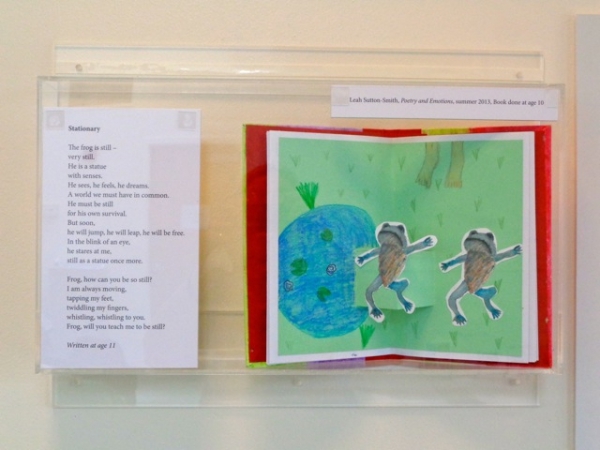MARLBORO — At the Poetry Studio in Marlboro, young people from age six to 15 have taken the opportunity to slow down and listen to their imaginations.
The results - poems, artwork, and beautiful handmade books from the past two years - will be on exhibit in the Gallery at the River Garden, 157 Main St., for the month of May.
The exhibit is called “Creative Visions: Poetry, Art, and Beautiful Handmade Books by Young People from The Poetry Studio in Marlboro, Vermont.”
“We want to honor and celebrate the students' work beyond a hilltop in Marlboro, and share it with the larger community,” said Ann Gengarelly, who founded the Poetry Studio in 1995. “We hope people will receive these offerings as gifts.
“Children's creativity is often dismissed,” she continued, “but there is more to children's work than most people assume. Often when parents see their children's poems, they say, 'I can't believe my child wrote that.'”
Gengarelly has worked as a poet-in-the-schools for more than 30 years. Time and time again, she said she has “witnessed students of all ages work toward a profound understanding of their own nature,” as they write and share poetry.
In creating the Poetry Studio 20 years ago, Gengarelly thought about the conditions that invite imagination and discovery. The physical space of the studio provides sensory stimuli to feed the creative spirit: fresh flowers; comfy pillows and couches; examples of artwork and poems on the walls; shelves of books on animals, plants, and birds; and art materials. Outside are landscaped gardens of flowers and other plantings.
“It's always a dance between the inside and the outside, both literally and figuratively,” Gengarelly said. “The quiet space invites the poet to sit with the self and pay attention. As Mary Oliver says, 'Attention is the beginning of devotion.'”
The intangible conditions for writing, equally important according to Gengarelly, include establishing an atmosphere of safety and community for all the writers.
“In the very first workshop, whether in the summer sessions or the after-school programs, we gather in a circle, and I talk about reverence and respect for each other,” she said. “I want them to feel respected as artist, writer, and human being. My antennae are up all the time, monitoring the tone. I've had students tell me the Studio is the one place where everyone is kind to each other all the time.”
Whether for children or adults, the sessions follow a general pattern: participants are invited to gather in a quiet circle; they listen to Gengarelly read poems by different poets on a theme; they disperse for individual work; then they re-gather for the final sharing and acknowledgement of each person's gift to the group.
A nurturing environment allows every person to find the voice that speaks from deep within, Gengarelly said.
“The act of writing a poem is the act of composing the self,” she said. “Often participants discover that they can say on paper what they can't say otherwise. They are reminded of what dwells inside them, and they are given space to listen to themselves. In the last circle where students offer their poems, we discover that, as human beings, we have a shared landscape. The stories are not the same, but are universal.”
Working with students on their writing can become delicate.
“It's a question of what opens the door and what shuts it,” Gengarelly said. “I always start with positives. I read body language. I let the student lead. We may talk about words or images or metaphors. I ask questions. But I always give the question back to the student to decide in order to honor his or her authentic voice.”
Gengarelly offers two options at the Poetry Studio: after-school programs once a week for eight weeks in the fall and again in the spring, or a four-day summer intensive workshop, currently being offered in August 2015 for the weeks beginning August 10 and 17. The summer curriculum focuses on nature in order to take advantage of the gardens in full bloom and the surrounding woodlands.
In the summer sessions, which run from 10 a.m. to 3:30 p.m., with no class on Wednesday of each week, students have both a poetry class with Ann Gengarelly and a bookmaking/art workshop with her husband, Tony Gengarelly.
“In 1999, Ann and I visited the Morgan Library in New York City for an exhibit of illustrated books,” said Tony Gengarelly, who is an art professor. “And we wondered, could we do this with students? So I took some bookmaking workshops to learn a variety of ways to present poetry and artwork. We use illustration and design to expand the meaning of the poetry, to expand words into visual imagery. It's an integral part of the writing process.”
The exhibit demonstrates the marriage between word and image, Tony Gengarelly explained. Sometimes a painting or collage accompanies a poem. Other times the student's art stands on its own as a visual statement. The handcrafted books on display introduce yet another form of artistic expression, becoming a vessel for the extraordinary poetry and art.
The students' poems and artwork in the exhibit show how an intense and focused creative engagement can revive those parts of the self so often neglected in the busy-ness of daily life.
“Working on a poem is similar to working in a garden,” Ann Gengarelly said. “You plant and you weed. And transformation happens. That metaphor weaves through all our work.”
